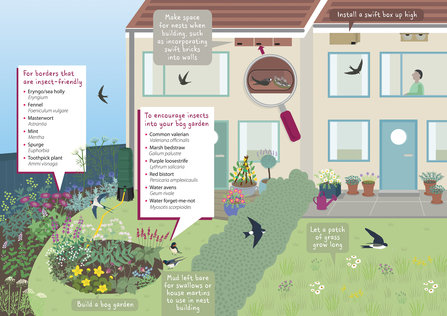
©Stefan Johansson
Action for Swifts
Swifts are amazing birds! Did you know that they have one of the longest migration distances of any bird? They commute an incredible 14,000 miles (22,000km) every year, passing through the airspace of around 25 different countries en-route!
But sadly our Swifts are in trouble...
Though we still see Swifts return to our shores each year, their soaring crowds are thinning out; their joyful screams quietening. In fact, Swift numbers have plummeted by 65% in just 25 years.
Swifts are in decline because they have fewer places to breed and less food. They nest under the eaves of buildings or in crevices in walls, which is bad news when building refurbishments mean these nooks and crannies are lost. Then there is the issue with their sole food source: insects.
Swifts eat as many as 100,000 flying insects a day. It’s a huge energy requirement, and with insects declining at a faster rate than ever before, many Swifts just can’t find enough food to sustain themselves.
© Nick Upton
How you can help
The main challenges facing Swifts are man-made, but the good news is there are some simple things you can do to make a big difference for them where you live.
1. Preserve Nest sites
Swifts return to the same nest site year after year and can take a long time to establish a new site if their favoured places disappear due to building work, demolition or blocked access. If you know that Swifts are nesting in your building, it's important to maintain access so that returning Swifts are not driven away. If you’re re-roofing, make new access holes as similar to the old ones as possible. Swifts can live for around twenty years so that can mean many successive visits.

© Nick Upton
2. Create new nest sites
If you don’t have these pre-existing Swift spots at home, put up a Swift box or install a Swift brick, either ready-made or you can build your own - find out how here. Install them high up on your building, with at least a five-metre drop and a clear flight-path in front of the entrance. The box or brick shouldn't be in direct sunlight, so placing it between north and east is usually best.
If you can, get a Swift brick as Swifts prefer them! They also last for the lifetime of the building they're installed in and don't need any maintenance.
As Swifts spend much of the year in southern Africa and are only in the UK from late April to August, they only spend about 10 to 12 weeks in their nests. Unlike other birds, they don't usually leave piles of droppings under their nest places, so they're incredibly trouble-free tenants.
3. Help in your community
Swifts have inspired many people to come together to help these fascinating birds. Across the UK, around 90 local groups are taking action for Swifts and there are groups across our area. They run surveys to find breeding sites, work to prevent nesting holes from being blocked, install nest boxes and raise awareness within their communities. Join or establish a local Swift Group or become a member of the Trust to support your local swift population and other wildlife on your doorstep.
4. Gardening for Wildlife
All our gardens combined are bigger in size than all of The Wildlife Trusts' nature reserves so wildlife-friendly gardening is always a good idea. There are a few simple steps you can take to provide food sources and roost places for wildlife - this will not only benefit swifts, but also other birds as well as bats and hedgehogs.
There are lots of tips for where to start in our free High Fliers guide!

